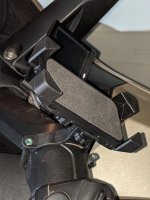Interestingly, one of the influencing factors is elevation. I've gotten some of my best MPG going over the Rockies on I-70. Some of the worst MPG occurred in Louisiana, just barely above sea level.
Hmmm, same here. I thought it was just me. Very good MPG, 2up, at high altitude. Lots of downshifting and tight turns.
I really wonder if it's actually the 'altitude' causing this ^^ or could it possibly be the fuel &/or fuel additive mix instead that's making for that particular fuel economy improvement? :dontknow:
Anyhoo, bear with me for a bit here.... We don't have too many 'high altitude' places here in Oz, but the Snowy Mountains & Victorian High Country do actually top 2000m a little (in places), they see snow each year, and because of that, they get a different fuel/fuel mix, and while it's been a while since I rode/drove over your way, I suspect that you too have 'specific to region/temp/altitude' fuel mixes in your 'higher altitude' regions. I think this 'different fuel mix' could at least be a significant contributor to the fuel economy improvement, certainly here in Oz anyway, cos every time I drive or ryde thru our High Country, my fuel economy improves markedly
only if I fill up with the 'Alpine Fuel' that's provided only in those regions - and if I
DON'T fill up with the Alpine Fuel stuff around those parts, then there's no measureable fuel economy change, except possibly a slight drop in fuel economy cos of the all the other drivers/vehicles we hafta put up with who just don't know how to drive in the 'Hills' where there might be lotsa those horrendous things called 'corners'!! :gaah:
Most years (cos this year
IS proving to be just a bit of an exception!

) the Child Bride & I ryde/drive across the country and thru the mountains so the Child Bride can visit with her family, who come from the Far South East Coast of New South Wales; so we get to travel over/thru what's pretty much the highest section of the Australian Great Dividing Range - which is our version of your Rockies, only ours are worn down to the stubs after a couple more million years of erosion!! :sour: If we time our travels right, or travel the 'Major Highway' route that most use to avoid the bulk of the really twisty & higher altitude bits (that have hills & corners & might get snow!!) we can & sometimes do (if forced to...

) head straight on thru the mountain region via without needing to refill with Alpine Fuel &/or until we hit the lower elevations on the far side... do that and our fuel economy for traversing the High Country bit remains pretty much the same as it does for the other twelve hundred miles or so of that particular trip, or maybe it's just a bit worse due to the previously mentioned impediments to smooth travelling!

.
BUT, if we instead go via one of the more scenic routes &/or plan the trip to include a refill just as we get into the foothils of the High Country, where they sell 'Alpine Fuel', we
ALWAYS get a marked & noticeable improvement in fuel economy that stays with us until we are half way thru the first 'non-Alpine fuel' tank of gas on the far side!! Same thing coming back- we get markedly better fuel economy than usual when & only when running on Alpine Fuel! :shocked:
This was
REALLY noticeable in my diesel 4WD back when I was doing a lot of 4WD Touring & travelling for weeks in the High Country, often carrying a few Jerry cans of Alpine Diesel in case one of my punters hadn't worked their fuel usage/range out too well, cos if we didn't need to fill up someone else's vehicle during the trip, I'd use it in my vehicle during the first few weeks after getting home again - and the fuel economy improvement showed up every time we added Alpine Fuel!! These days, we don't get to do that anywhere near as often with our petrol engined Spyder or cars, but the same thing still applies - if we have a spare Jerry can or two of Alpine ULP (95 RON) that we only get to use a few weeks after travelling thru the High Country, we can see the same fuel economy improvement we get in the higher altitude regions!! And it's not just
me experiencing this, many others have noticed it & commented on it, and many of the locals or regular travellers in those regions make a practice of planning their 'out of region' travels to minimise their need to fill up with any less economical 'non-Alpine fuel'!

hyea:
So maybe that's worth looking into that over there, cos possibly it's the differenes in the available fuel mix that's making for some of the difference in fuel economy rather than it actually being directly (or solely :dontknow: ) attributable to
just the higher altitude. Worth looking into, isn't it??


